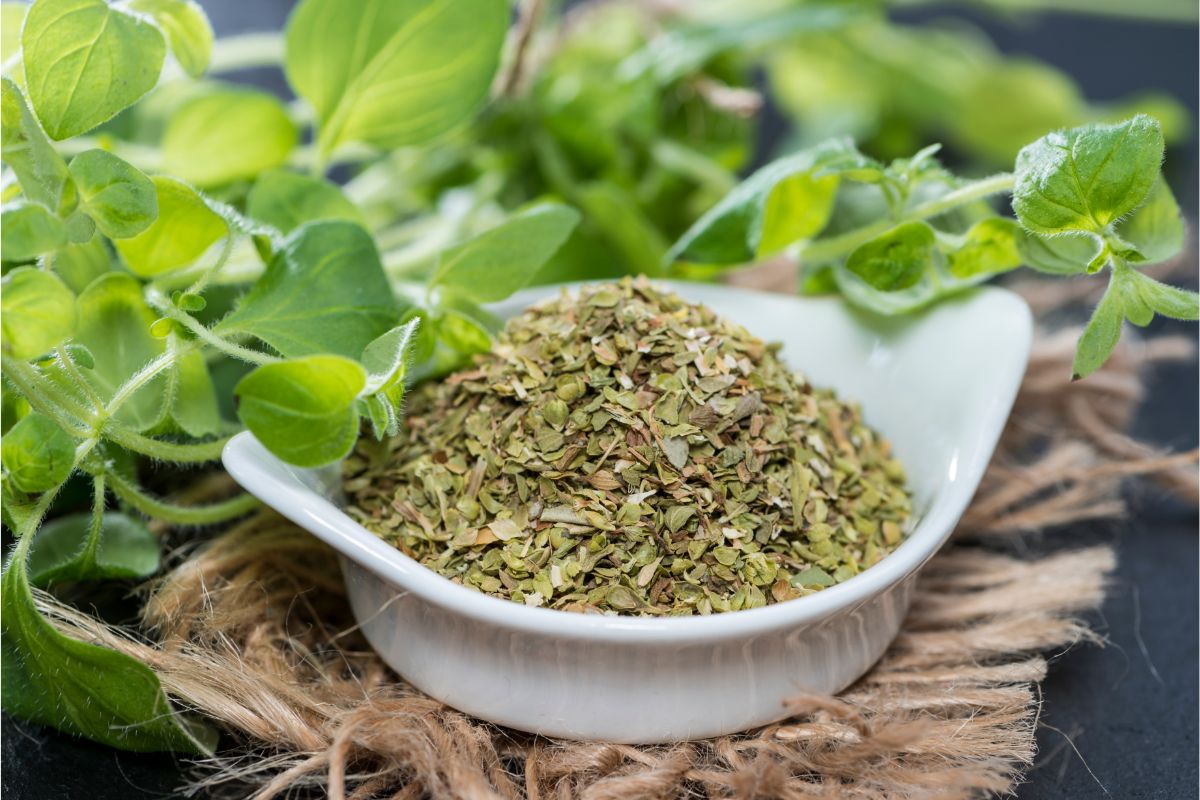Oregano can be dried in three ways. To hang dry, tie your oregano into a bunch and leave in a dry, warm room for two to six weeks. To use a food dehydrator, set it to the lowest temperature and dry for 6-18 hours. To oven dry, set the oven to 180°F, prop open the door, and bake the herbs for 2-4 hours until brittle.
Table of Contents
How to Dry Oregano for the Best Flavor
Ready to make some DIY dried oregano? There are a few different methods you can try! The three most common methods are hang drying, using a food dehydrator, and oven drying.
Hang Drying
This is probably the most cost-effective and easy method to dry fresh oregano. It requires no special food preservation equipment other than some twine and a room with good airflow.
- Harvest a few oregano sprigs from your herb garden. Tie the oregano stems together using twine or rubber bands to create a small bunch.
- Hang the bundle upside down in a dry room with good air circulation. Hang the bunch where it will receive direct sunlight from a window.
- Leave to air dry for two to six weeks. When the herbs are dehydrated and brittle to the touch, store them in an airtight container.
Food Dehydrator
If you want your herbs dried more quickly, using a food dehydrator is the most fail-safe drying method.
- Wash your oregano sprigs in cool, running water, and then pat them dry.
- Lay them in a single layer on a dehydrator tray. Ensure they are evenly spaced.
- Set the food dehydrator to the lowest setting, ideally between 95°F and 125°F.
- Allow them to dry at the lowest temperature until they are thoroughly dehydrated. This should take between six and eighteen hours.
Oven Drying
If you need quick-dried herbs but don’t have a dehydrator, you can use your oven. Convection ovens work better than standard due to the air-circulation feature but standard ovens can also be used.
- Wash your oregano and pat dry using a paper towel.
- Line a baking sheet with parchment paper.
- Lie a single layer of fresh oregano across the baking tray, evenly spaced.
- Place into a preheated oven set to 180°F.
- If using a standard oven, prop open the door using a wooden spoon for good airflow.
- Bake for two to four hours, checking periodically until dry and brittle.
- Remove from the oven and allow to cool before storing.
How Long Does it Take to Dry Oregano?
The time it takes to dry oregano depends on the method. Oven baking is the quickest drying method, taking between two and four hours.
Using a dehydrator tray takes between six and eighteen hours, including prep time.
Air drying is the slowest method – it usually takes between two and six weeks for the herbs to be fully dry.
Print
Epic Italian Seasoning with Home Dried Oregano
- Total Time: 6 hours, 5 minutes
Description
Italian seasoning is a delicious herb mix that goes into many of our favorite recipes! It can be store-bought, but it is super easy to make yourself (and likely will taste better). It goes deliciously in soups, sauces, on pizza, or in pasta!
Ingredients
- 2 tbsp homemade dried oregano (yield from 6 sprigs of fresh oregano).
- 2 tbsp dried basil
- 2 tbsp dried parsley
- 2 tbsp dried rosemary
- 1 tbsp dried thyme
- 1 tbsp red chili flakes
- 1 tsp garlic powder
Instructions
Homemade Dried Oregano
- Gather 6 sprigs of fresh oregano. A sprig is a branch roughly 4″ to 6″ long. Wash your oregano sprigs in cool, running water, and then pat them dry.
- Place the sprigs in a single layer on a dehydrator tray, ensuring even spacing.
- Set the food dehydrator to the lowest setting, which should be between 95°F and 125°F.
- Allow them to dry at the lowest temperature until dried, between 6 and 18 hours.
- Once dried, remove the oregano leaves and gently crumble into pieces.
Epic Italian Seasoning
- Gather your dried spices together.
- Measure out the appropriate amount of each spice, and add to a single mixing bowl.
- Once all the ingredients are added together, mix with a whisk or lightly toss until well-incorporated.
- Use a siphon or funnel to take your Italian seasoning and pour it into a small, airtight spice jar.
- Store your dried Italian seasoning in a cool, dry location until ready to use! Enjoy!
- Prep Time: 5 minutes
- Drying Time: 6 – 18 hours
What are the Benefits of Drying Oregano?
The biggest benefit of drying oregano is that it lasts longer than fresh herbs. Dry oregano leaves will usually last for between one and three years after the drying process; for comparison, the leaves of a fresh oregano plant will wilt in just three days of being stored in the refrigerator.
Oregano, like other herbs, is an excellent source of antioxidants and essential oils. The dried version retains these health benefits in a smaller, more compact package.
Is it Better to Dry Oregano at Room Temperature or in the Oven?
This entirely depends on personal preference and how fast you need them. Oven-drying is a good method, and only takes a few hours.
However, the natural process of air drying tends to make for a better and more consistent product. It is also easier – oven drying can go wrong if you’re not paying attention, leading to burnt and ruined herbs. Hang drying is a foolproof method.
How to Store Dried Oregano
Store your dried oregano in a cool, dark, dry place in an airtight container such as a glass jar or mason jar. As with any dried herb, such as dry basil, chives, or scallions, storing herbs this way is the best method for ensuring freshness.
Shelf Life of Dried Oregano
Dried oregano can last for up to three years if stored correctly. However, it is recommended you consume it within six months to ensure maximum flavor and freshness.

